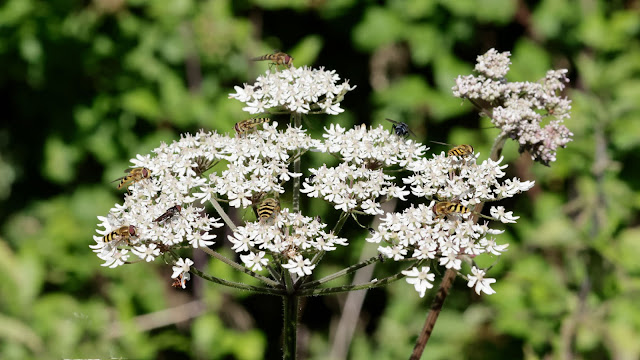A brilliant idea from Titchfield Haven, an early opening day. The problem was it is the middle of July in some of the hottest weather of the year and there were very few birds about. Nevertheless it was a chance to get around the reserve in the cooler conditions of the morning and I met Ian at just before 7.00am. After checking in we walked around the sea wall to the west side of the reserve and into the Meon Shore Hide.
It was very quiet aside from the calls of Black-headed Gull chicks and the squabbling Common Terns. There was a group of Avocet at the back end of the scrape and several groups of Black-tailed Godwits either feeding or roosting. The water levels were surprising still rather high, but there were some patches of mud, and it was probably these that attracted a Common Sandpiper. It showed itself as it flew around the scrape and then off into the bay.
We left the hide and walked around to the pools outside the Pumfrett Hide. We were looking for the Norfolk Hawkers that have been consistently seen over the last week. Ian and I had seen them on our last visit here. Unfortunately we were not able to find them, but there were some other early rising dragonflies.
A Four-Spot Chaser.
Female Beautiful Demoiselle.
And a Blue-tailed Damselfly.
We looked into the other two hides on the west side, but other than the drake Goosander (now in eclipse once more) and a Common Sandpiper it was very quiet.
Walking back we stopped off in the Meon Shore once more. The Common Terns were still flying around.
Then from nowhere these two juvenile Little Ringed Plover appeared on one of the islands. Incredibly the heat haze was kicking in by now.
Just as quickly as they appeared the plovers were gone! With little else to see we set off for the east side, stopping out on the road to check the mud in the bay. There were three Redshank and two Common Sandpipers. This was one of the sandpipers.
The Broad-leaved Helleborine was still not flowering and a walk around the Walkway Pond didn't find any dragonflies. We walked down towards the Knight's Bank Hide, checking the blackthorn bushes. A couple of years ago a Brown Hairstreak was seen here. The habitat is ideal with the Blackthorn and below Hemp Acrimony to nectar on. There were Comma, Gatekeeper and a few Small Skippers, but no hairstreaks. What was interesting was the number of small Hover Flies that were nectaring on the wild Yarrow.
At this time of year there is the pilgrimage to Browndown South once again. The reserve hasn't been open that much over the last couple of months, but this weekend it was open. At this time of year the Grayling start to appear, a brown butterfly easily missed as it zips about amongst the heather and pebbles.
It didn't take long to find one and it seemed to be wanting to get out of the sun. I followed it around the heather until it settled, fortunately with the "eye" on the upper wing showing.
I then came across another one that settled on a dead branch, again showing the "eye" off nicely.
With the Grayling found it was off to try and find the other specialty here, the Purple Hairstreak. The area is covered with dwarf oaks, the flat habitat keeping them from growing tall as they would in normal conditions. They rarely grow any higher than six feet and this means you can see these oak loving butterflies at eye level for once. It is a case of walking around the trees and shaking the branches. We did this and pretty soon we found a couple that settled back on to the leaves.
The Purple Hairstreaks have been around early this year and we expected them to be a little worn, but it was a nice surprise to see them in such good condition.
That was it until next year!
There had been a report of a Silver-studded Blue being around the heather, but despite a lengthy search we couldn't find any. I did though manage to find another Grayling showing well, this time on the Bell Heather.
A distraction was the Spitfire out of Daedalus, flying out over our heads and then out over the Solent. Apparently the black and white lines were part of the planes livery during the Normandy landings to identify the aircraft as "one of our own".
Another Grayling perched beautifully amongst the pebbles, shame the upper wing was dropped this time.
We eventually found a blue butterfly, but this was a Common Blue.
And plenty of skippers, this one an Essex Skipper.
By lunchtime it was very hot and there was not going to be much to see, so we decided to retreat to the shade and call it a day.






















No comments:
Post a Comment